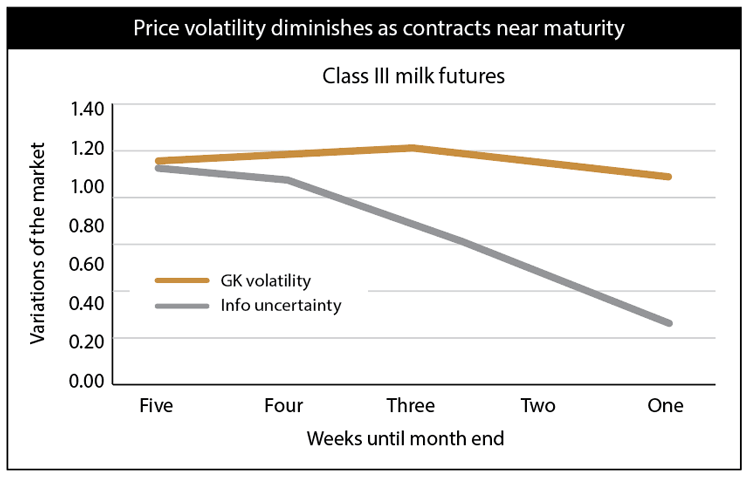In the simplest terms, price volatility is the change in a commodity’s price over time. Daily, weekly, monthly, and annual periods are often typical points to track to reference price movements. No matter what the time horizon, the major dairy products, including cheese, butter, dry whey, and raw farm milk, represented by Class III, have experienced dramatic and seemingly random price swings in the past several decades. Since dairy products show unpredictable price volatility, it can be difficult for dairy farmers, manufacturers, and other market participants to manage price risks.
Why is understanding dairy price volatility important?
The answer is twofold.
First, understanding dairy price volatility and what factors may influence substantial price movements is essential to manage risk and protect profitability. Second, since the dairy industry is one of the most heavily regulated sectors by the United States Department of Agriculture (USDA), it is crucial to investigate how dairy commodity prices respond to the USDA announcements in the current milk pricing system. This also will help us understand the potential role the government could play in calming the volatile dairy markets.
Looked at four commodities
In our recently published study in the Journal of Commodity Markets, we utilize price data from the CME dairy futures market beginning in August 2010 and ending in December 2021. This span, across 125 months, helped create a price volatility timeline for Class III milk, cheese, butter, and dry whey.
We then utilized multiple econometric models to calculate the interactions of the price volatility timelines among the four dairy commodities. As a result, we can now measure price volatility spillover or connectedness among dairy commodities.
We find that daily price discovery for Class III milk, butter, cheese, and dry whey are positively correlated yet show significant variation over time. Class III milk and cheese are most closely correlated while dry whey is the least correlated with the others, suggesting a striking independence. We also found that dairy futures markets are not closely correlated to the overall commodities futures market. We observe that volatilities increased considerably during the COVID-19 pandemic. The trading volume and open interest also spiked dramatically during the pandemic.
In the connectedness of volatility spillover analysis, we find the total volatility connectedness among the four dairy commodities is much lower than other regularly traded commodities such as oil or gold, for example. However, total dairy volatility connectedness rose significantly during the COVID-19 pandemic.

Our results also show low pairwise volatility connectedness (spillover) among these four dairy commodities. The highest spillover is between cheese and milk, about 40%, while the lowest is between dry whey and butter, about 1%.
Our results demonstrate that dairy futures markets respond to the information released by the USDA weekly National Dairy Products Sales Report (NDPSR) wholesale pricing reports through the Federal Milk Marketing Order (FMMO) pricing scheme. We quantify the pricing information released by the wholesale reports through a measure of information uncertainty.
Our results show that information uncertainty and dairy volatility are reduced when the futures contract approaches maturity at the end of the month. The figure illustrates how Class III milk’s price volatilities (illustrated by the GK measure of volatility) and information uncertainty change over the month before maturity.
The uncertainty spike
On a weekly basis, information uncertainty reaches its highest level on Tuesdays (the day prior to the NDPSR release) and falls on Wednesday, the report’s announcement day. Our regression analyses suggest improved information uncertainty reduces volatility after controlling other variables, such as trading activities and overall futures market trends.
Our study thoroughly analyzes four major dairy commodities’ price volatilities that have not been explored. Surprisingly, our study demonstrates that the price volatility spillovers among dairy commodities, which naturally share a common raw ingredient — farm gate milk — are much lower than expected. Because identifying the source of volatility is necessary to manage risk, our findings are important to decision makers in both the agricultural sector and with policymakers alike.
The findings also contribute to the ongoing debate on the usefulness and even the effectiveness of the FMMO. As those throughout the dairy community know, the FMMO helps determine the minimum price for milk processors and farmers and attempts to provide stable market conditions of which volatile prices are an objectionable characteristic.
At the same time, various regions have had different experiences with the FMMO. For example, the Western FMMO was terminated in 2004. Yet, California dairy producers approved joining the FMMO in 2018. Given the recent supply chain disruptions caused by the pandemic, the Congressional Research Service has begun a review of the FMMO. Our results suggest that enhancements to the FMMO have the ability to reduce market volatility.








